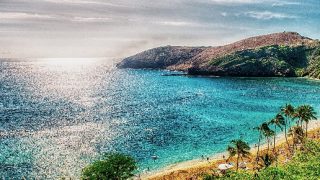Oahu’s North Shore was never intended to be luxury. For decades, it was the island’s escape, where visitors and residents alike could watch world-class waves, stop at a shrimp truck, or stay the night at a place that felt rustic compared to Waikiki’s glitz. Oahu surf country always carried its rough edges, and that was part of the appeal.
That picture is shifting fast. Turtle Bay, which was long considered a mid-market holdout, officially rebranded as The Ritz-Carlton O‘ahu, Turtle Bay on July 31, 2024, signaling a complete shift into the ultra-luxury category. The sale price itself was staggering, at around $680 million depending on the source, and follows the resort’s long history of changing hands.
Guests will also encounter new layers of cost, including higher fees, valet parking, and Hawai‘i’s steep 19% visitor accommodation tax, which together push rates far above what North Shore travelers have ever paid. This reflects a larger trend in Hawaii tourism where luxury hotel operators are steadily replacing vacation rentals that once provided more accessible lodging choices.
Now, right next door, 65 acres are under development for additional Ritz-branded residences and hotel rooms. Together, they mark the arrival of ultra-luxury at a shoreline that once stood for something different and more accessible. The change is not just physical construction. It feels like another identity rewrite, this time of Oahu’s arguably most famous coastline.
Ritz-Carlton moves in at Turtle Bay.
When Blackstone sold Turtle Bay Resort to Host Hotels for around $700 million in 2024, the Ritz-Carlton announcement that followed was more than a rebrand. It was a signal that the North Shore would no longer sit outside Hawaii’s ultra-luxury map.
The shift also reflects Hawaii’s regulatory and political environment, which increasingly favors large hotel operators at the expense of smaller and more affordable vacation rentals that once defined North Shore Oahu stays, before the 2022 law forced many of them to adopt 30-day minimums.
Then came Utah-based Arete Collective, which spent $43 million for the adjoining parcel. Construction began this spring on 100 resort residences, with up to 250 hotel rooms to follow. The first 20 units are slated for completion in 2027. With two overlapping Ritz-Carlton projects, the North Shore will now mirror Wailea, Kapalua, and Princeville. That is a shift no one would have imagined just a few years ago.


Nearly no mid-range options remain on Oahu’s North Shore.
For years, Turtle Bay offered something somewhere in between. It was not cheap, but it was not Wailea either. That balance has disappeared. Ritz branding has already lifted Turtle Bay off-season (fall) rates into the $900+ range, including taxes and fees, as you’ll see in the image above.
At the same time, Oahu’s 2022 crackdown on short-term rentals virtually erased the other major supply of North Shore lodging. Many of the Haleiwa beach houses, Sunset Beach surf pads, and Waimea cottages that once offered visitors more affordable options were converted to 30-day minimum rentals.
There are exceptions, however, when we checked Airbnb rentals for September. We found short stays available for around $300 plus nightly. Those listed may have been grandfathered in and are legal.
The effect, however, is apparent. There is little middle ground left, except for the Courtyard Marriott in Laie, which is conveniently located near the Polynesian Cultural Center, Brigham Young University-Hawaii, and the LDS Laie Hawaii Temple.


Exclusivity is the new model.
The developer emphasizes shoreline setbacks of up to 300 feet, dune restoration, and the preservation of open space. Seventy percent of the land will remain undeveloped, invasive trees are being removed, and beach erosion is being addressed. Yet these elements do not change the trajectory of this development. The project is not for the average traveler. It is for a small clientele with the means to buy in or book at nose-bleed Ritz-level prices.
This exclusivity extends beyond room rates. Gated communities, private amenities, and a brand that signals separation are replacing Hawaii’s once-open and casual atmosphere, which also defined Oahu’s North Shore.
Culture and environment in the spotlight.
The transformation is not without resistance. In July, ancestral remains (iwi kupuna) were discovered on the construction site, forcing work to pause and consultations to begin. For many residents, it was proof too that sacred ground is at risk.
Skepticism is also rooted in the people behind the project. Several Arete executives came from Discovery Land Co., a developer criticized for environmental practices elsewhere. Even as Arete touts its partnership with the North Shore Community Land Trust, the community remains cautious.
For visitors, it adds another layer of complexity. The North Shore is no longer just a scenic stop. It is now the center of a broader struggle over land, heritage, and who Hawaii’s future is built for.
Traffic and access realities.
The North Shore’s only road, Kamehameha Highway, is already clogged. Under current agreements, upgrades are not required until nearly 100 residences are complete. That means gridlock will likely intensify far before any relief arrives. Even so, the project is still governed by the 1986 unilateral agreement and the 2015 conservation easement, which ensure public shoreline access and cap overall development.
Public access will technically remain. Area trails, such as Kahuku, and shoreline points are expected to stay open. Yet the visitor experience will not be the same. Construction fences, parking adjustments, and reshaped dunes will alter the coastal experience. A place once valued more for its rugged, natural openness is becoming a curated luxury frontage.
What North Shore travelers should expect.
In the near term, visitors will start to see both change and disruption. Expect ever-increasing room rates, construction zones, and longer drives. The only available hotel other than the Laie Courtyard Marriott will be the Ritz-Carlton Turtle Bay.
Day trips from Waikiki and Ko Olina will still deliver big, with surf breaks, plate lunches including Giovanni’s Shrimp Truck, and a glimpse of the past and Oahu’s old surf town spirit. But they will also reveal the ongoing conversion of the North Shore into another luxury destination.
The transformation is happening, and the direction is clear. What remains in doubt is whether the old surf country feeling will last. For visitors and residents who came here for a more authentic slice of Hawaii, the real question is whether there will still be a place for any of us on the North Shore.
What’s your take on Oahu North Shore development?
Get Breaking Hawaii Travel News







Our 30th anniversary is coming and because our honeymoon was spent on Maui, we thought we would go back to one of the islands.
Oceanfront is important and unaffordable.
However its the mess of it all that will likely have us head somewhere else.
Its all of the bad news with vrbo displacing locals and the local officials dealings with the fires the way they did.
Its just too much overall, vacation is supposed to be relaxing.
Ill probably give Hawaii a few more years before going back.
Don’t make it for the rich and famous. Allow people to travel and visit the land it’s ridiculous
It’s sad that greed, and catering to the semi and ultra rich, is messing things up. I surf the north shore when I visit, but after reading this article, I’ll wait and see, but I may go elsewhere for vacationing and surfing